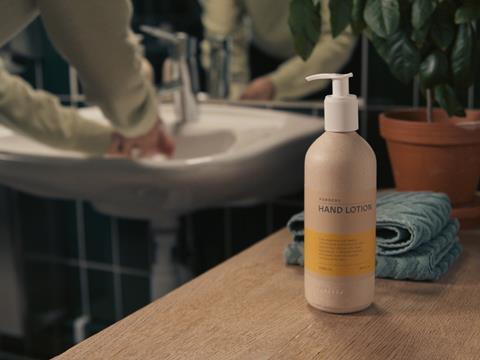
Earlier this month, Paboco made an important announcement regarding its paper-based bottle products. The company has launched full-scale production and is aspiring to produce over 20 million fibre-based bottles by the end of 2025. Paboco’s CEO, Tim Silbermann, tells us more about this news, as well as shedding more light on the company’s recent acquisition by ALPLA, in our latest interview feature.
We’ve been reporting on Paboco’s solutions for a while now, across multiple different iterations and projects. But, for readers who may have missed that, could you give us some background on the history of Paboco from its inception up until now?
Sure. Paboco was founded in 2019 out of the startup ecoXpac by ALPLA and, back then, BillerudKorsnäs (now Billerud). At the same time, we created the Pioneer Community, which was the coming-together of five big consumer brands to develop the paper bottle with us across multiple generations.
We continued with developing the ‘Generation 1 bottle’ (machines, processes, barrier applications, et cetera) and the pioneers put those bottles on the market and created consumer learnings on how the bottle behaved during processes such as filling and logistics.
But, following the vision of Paboco, we continued with intense focus on reducing the amount of barrier needed – which meant developing new technology (again). Following 18 months of development, with the onset of the next generation and new machines to manufacture at a larger scale, we are ready.
Let’s discuss this latest update now – could you give us an overview of the full-scale production launch?
With this launch, we mark the next phase of Paboco. We will move into a new site, establish new machines, upscale our process and launch the next generation paper bottle. We continue to work with our leading pioneers, but we are also looking for other brands to join us on this.
We are going to meet the demand for establishing additional lines over the next years and grow even more from there.
This step resolves around the next generation of the paper bottle. We announced the first bottle in 2022 as a prototype, but it took us the last year to properly establish our process, get machines up and running, and validate the product.
What is the overall carbon impact of this latest solution? How is this measured, and how does its impact compare with PET bottles?
We conducted an LCA study at the end of 2022 together with the Implement Consulting Group to benchmark our next generation bottle against other packaging solutions. The LCA was conducted according to ISO standards.
The other packaging solutions are averages from other available LCA studies. In comparison, our solution (the scaled version) already looks very good, when you remember that the technology is just a couple of years old now.
We are already very close in comparison to a plastic bottle, and outperform it when biogenic carbon uptake is considered. This is done on our own bottle and design, so this needs to be looked at and calculated for every new use case, of course.
Whenever we share updates regarding Paboco, some of our readers comment their belief that your solutions are merely plastic bottles with paper sleeves. How would you respond to this, and could you give us an update on the company’s goal of creating a 100% biobased bottle? How far away is it?
We were always very transparent about the status/generation of packaging solution we are in right now. For generation 1, yes – the plastic liner was quite significant in weight. Could such a thin liner have worked without the paper shell around it? No – the paper bottle was always the carrier of strength and rigidity, that’s why we could reduce the plastic content in the first place.
But this was our first step in proving large parts of our process and scalability – basically from handmade to automated pilot production. Now we take the next step in reducing the barrier content even more, and what’s left is a thin fill on the bottle inside.
Our technology allows us to use multiple materials, so biobased materials for the barrier will be an option in the near future. Additionally, we always strive to reduce barrier needs as much as possible. Depending on the use case, we want to be as resource-conscious as possible.
Late last year we reported on ALPLA becoming the principal stakeholder in Paboco. What does this mean for the company, and how does Paboco fit into ALPLA’s overall strategy?
First and foremost, this means a commitment to Paboco’s journey and plans for the future. We are happy that ALPLA sees the continuous value of the Paboco technology and product, and has trust in the Paboco team here in Denmark.
ALPLA’s strategy is to provide sustainable packaging solutions worldwide – a paper bottle fits into this purpose nicely. With ALPLA’s help, we can now accelerate to get volumes to the market.
Why did Billerud decide to sell its majority stake in Paboco? Does the fact that your company’s shift in majority ownership from Billerud (which mostly produces pulp and paper packaging) to ALPLA (which mostly produces plastics) change anything about its direction?
This was a strategic decision from Billerud’s side, focusing more on their core business. And the switch here does not mean a change in Paboco’s direction and trajectory, as said before. The paper bottle is a valuable addition to the packaging market as a whole.
If you liked this story, you might also enjoy:
The Brief: How viable is biorecycling for plastics?
Report: How the top brands are progressing on packaging sustainability
The Brief: Using ocean-bound plastic in packaging – how, why and should we?





















No comments yet